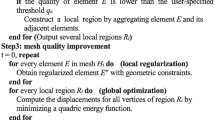Abstract
The models for finite element analysis usually have a number of complex geometric features such as holes, slots, and curved surfaces, etc. The exact description of these features is crucial to the accuracy of finite element analysis. This paper presents an algorithm for the adaptive generation of the initial hexahedral element mesh based on the geometric features of the solid model. This algorithm is a modified grid-based method, in which a new geometry-adaptive hexahedral mesh generation method and a new mesh boundary matching method called threading method are established and employed. Firstly, an initial grid structure, which is uniformly sized or locally refined and encompasses the solid model completely, is generated based on the geometric features of the solid model. Then, an initial indention mesh is generated after removing all the elements in the exterior of the solid model using the even-odd rule. The surface of the indention mesh, which is adaptively generated based on the geometric features, is so complicated and different in size that the match of the edges and surface to the surface of the solid model becomes inconvenient. In this case, the closest position tracing approach used widely is difficult to realize an accurate match. The threading method proposed in this paper can accurately match the boundaries of the indention mesh to the boundaries of the solid model. Especially, it is fit for the generation of the geometry-adaptive mesh and avoids the recurrent search process of characteristic boundary nodes in the closest position tracing method. So the efficiency of the finite element mesh generation is enhanced remarkably. The principles and procedures of the algorithm are illustrated through the geometry-adaptive hexahedral mesh generation of a typical three-dimensional solid model. The effectiveness and robustness of the algorithm are tested by several applications in the complex solid models.





















Similar content being viewed by others
References
Quadros WR, Shimada K, Owen SJ (2004) Skeleton based computational method for the generation of a 3D finite element mesh sizing function. Eng Comput (Lond) 20(3):249–264
Zienkiewicz OC, Zhu JZ (1987) A simple error estimator and adaptive procedure for practical engineering analysis. Int J Numer Methods Eng 24:337–357
Zienkiewicz OC, Zhu JZ (1992) The super-convergent patch recovery (SPR) and adaptive finite element refinement. Comput Methods Appl Mech Eng 101(1–3):207–224
Frey PJ, George PL (2000) Mesh generation. Application to finite elements. Hermés Science Publishing, Oxford, Paris
Cook WA, Oakes WR (1982) Mapping methods for generating three-dimensional meshes. Computers in Mechanical Engineering, CIME Research Supplement 67–72
Shimada K, Mori N, Kondo T et al (1999) Automated mesh generation for sheet metal forming simulation. Int J Vehicle Des 21:278–291
Tchon K-F, Khachan M, Guibault F, Camarero R (2005) Three-dimensional anisotropic geometric metrics based on local domain curvature and thickness. Comput Aided Des 37(2):173–187
Frey PJ (2000) About surface remeshing. In: Ninth International Meshing Roundtable, Sandia National Laboratiories, New Orleans, LA, pp 123–136
Blacker T (1996) The Cooper tool. In: Proceedings of the 5th international meshing roundtable, pp 13–29
Lai M, Steven EB, Sjaardema G, Tautges T (1996) A multiple source and target sweeping method for generating all hexahedral finite element meshes. In: Proceedings of the 5th international meshing roundtable, pp 217–228
Knupp PM (1998) Next-generation sweep tool: a method for generating all-hex meshes on two-and-one-half dimensional geometries. In: 7th international meshing roundtable, pp 505–514
Blacker TD, Meyers RJ (1993) Sams and wdges in pastering: a 3D hexahedral mesh generation algorithm. Eng Comput 2:83–93
Meyers RJ, Timothy JT, Tuchinsky PM (1998) The Hex-Tet hex-dominant meshing algorithm as implemented in CUBIT. In: Proceedings of the 7th international meshing roundtable, pp 151–158
Murdoch P, Steven EB (1995) The spatial twist continuum. In: Proceedings of the 4th international meshing roundtable, pp 243–251
Tautges TJ, Blacker T, Mitchell SA (1996) The whisker weaving algorithm: a connectivity-based method for constructing all-hexahedral finite element meshes. Int J Numer Methods Eng 39:3327–3349
Schneiders R (1997) An algorithm for the generation of hexahedral element meshes based on an octree technique. In: Proceedings of the 6th international meshing roundtable, pp 183–194
Lee YK, Yang DY (1999) Development of a grid-based mesh generation techniques and its application to remeshing during the finite element simulation of a metal forming process. Eng Comput 16:316–336
Zhu J, Blacker T. Overcoming Cartesian grid generation obstacles. In: Proceedings of the 7th international conference on numerical grid generation in computational field simulations, September 2000
Smith R (1996) A novel Cartesian grid method for complex aerodynamic CFD applications. In: 5th international conference on numerical grid generation in computational field simulations, pp 709–718
Kwak DY, Im YT (2002) Remeshing for metal forming simulations—part ii: three-dimensional hexahedral mesh generation. Int J Numer Methods Eng 53:2501–2528
Tchon KF, Khachan M, Guibault F, Camarero R (2003) Constructing anisotropic geometric metrics using octrees and skeletons. In: 12th international meshing roundtable, Santa Fe, pp 293–304
Rosenfeld A (1979) Digital topology. Am Math Mon 86(8):621–630
Kong TY, Rosenfeld A (1989) Survey digital topology: introduction and survey. CVGIP 48:357–393
Schneiders R (1996) Refining quadrilateral and hexahedral element meshes. In 5th international conference on numerical grid generation in computational field. Simulations. Mississippi State University, pp 679–688
Wada Y, Okuda H (2002) Effective adaptation technique for hexahedral mesh. Concurr Comput Pract Exp 14:451–463
Acknowledgments
This research work is supported by National Natural Science Foundation for Distinguished Young Scholars of China (No. 50425517) and National Natural Science Foundation of China (No. 50375087).
Author information
Authors and Affiliations
Corresponding author
Rights and permissions
About this article
Cite this article
Zhao, G., Zhang, H. & Cheng, L. Geometry-adaptive generation algorithm and boundary match method for initial hexahedral element mesh. Engineering with Computers 24, 321–339 (2008). https://doi.org/10.1007/s00366-007-0085-7
Received:
Accepted:
Published:
Issue Date:
DOI: https://doi.org/10.1007/s00366-007-0085-7




